
Acrylic paint is a fast-drying paint made of pigment suspended in acrylic polymer emulsion and plasticizers, silicone oils, defoamers, stabilizers, or metal soaps. Most acrylic paints are water-based, but become water-resistant when dry. Depending on how much the paint is diluted with water, or modified with acrylic gels, mediums, or pastes, the finished acrylic painting can resemble a watercolor, a gouache, or an oil painting, or have its own unique characteristics not attainable with other media and are meant for canvases.

Jan Josephszoon van Goyen was a Dutch landscape painter. The scope of his landscape subjects was very broad as he painted forest landscapes, marine paintings, river landscapes, beach scenes, winter landscapes, cityscapes, architectural views and landscapes with peasants. The list of painters he influenced is much longer. He was an extremely prolific artist who left approximately twelve hundred paintings and more than one thousand drawings.

Oil painting is a painting method involving the procedure of painting with pigments with a medium of drying oil as the binder. It has been the most common technique for artistic painting on canvas, wood panel or copper for several centuries, spreading from Europe to the rest of the world. The advantages of oil for painting images include "greater flexibility, richer and denser colour, the use of layers, and a wider range from light to dark". But the process is slower, especially when one layer of paint needs to be allowed to dry before another is applied.
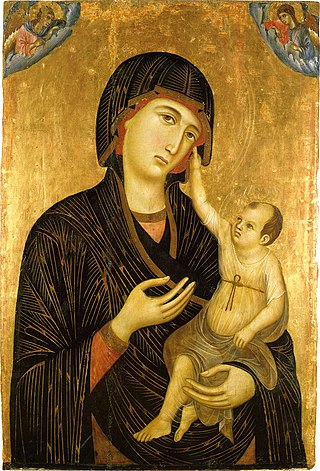
Tempera, also known as egg tempera, is a permanent, fast-drying painting medium consisting of pigments mixed with a water-soluble binder medium, usually glutinous material such as egg yolk. Tempera also refers to the paintings done in this medium. Tempera paintings are very long-lasting, and examples from the first century AD still exist. Egg tempera was a primary method of painting until after 1500 when it was superseded by oil painting. A paint consisting of pigment and binder commonly used in the United States as poster paint is also often referred to as "tempera paint", although the binders in this paint are different from traditional tempera paint.

Gesso, also known as "glue gesso" or "Italian gesso", is a white paint mixture used to coat rigid surfaces such as wooden painting panels or masonite as a permanent absorbent primer substrate for painting. It consists of a binder mixed with chalk, gypsum, pigment, or any combination of these.

Papier-mâché, frequently miswritten as paper mache, is a composite material consisting of paper pieces or pulp, sometimes reinforced with textiles, and bound with an adhesive, such as glue, starch, or wallpaper paste.
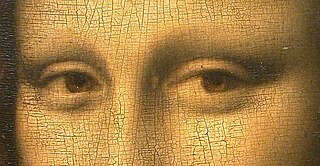
Craquelure is a fine pattern of dense cracking formed on the surface of materials. It can be a result of drying, shock, aging, intentional patterning, or a combination of all four. The term is most often used to refer to tempera or oil paintings, but it can also develop in old ivory carvings or painted miniatures on an ivory backing. Recently, analysis of craquelure has been proposed as a way to authenticate art.

Sgraffito is a technique either of wall decor, produced by applying layers of plaster tinted in contrasting colours to a moistened surface, or in pottery, by applying to an unfired ceramic body two successive layers of contrasting slip or glaze, and then in either case scratching so as to reveal parts of the underlying layer. The Italian past participle sgraffiato is also used, especially of pottery.

A panel painting is a painting made on a flat panel of wood, either a single piece or a number of pieces joined together. Until canvas became the more popular support medium in the 16th century, panel painting was the normal method, when not painting directly onto a wall (fresco) or on vellum. Wood panels were also used for mounting vellum paintings.
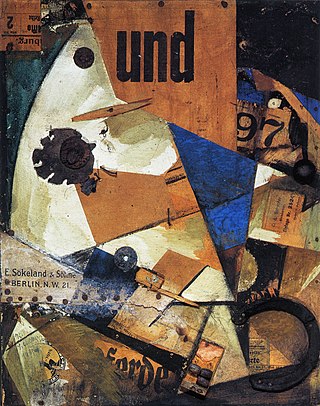
Collage is a technique of art creation, primarily used in the visual arts, but in music too, by which art results from an assemblage of different forms, thus creating a new whole.
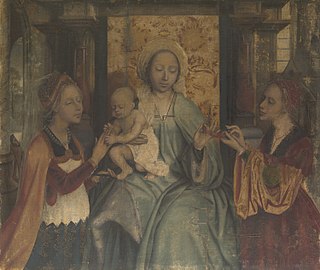
Glue-size is a painting technique in which pigment is bound (sized) to cloth with hide glue, and typically the unvarnished cloth was then fixed to the frame using the same glue. Glue-size is also known as distemper, though the term "distemper" is applied variously to different techniques. Glue-size was used because hide glue was a popular binding medium in the 15th century, particularly among artists of the Early Netherlandish period, who used it as an inexpensive alternative to oil. Although a large number of works using this medium were produced, few survive today, mainly because of the high perishability of linen cloth and the solubility of hide glue. Well-known and relatively well-preserved – though substantially damaged – the most notable examples include Quentin Matsys' Virgin and Child with Saints Barbara and Catherine and Dirk Bouts' Entombment. In German the technique is known as Tüchleinfarben, meaning "small cloth colours", or Tüchlein, derived from the German word for “handkerchief”.
The detachment of wall paintings involves the removal of a wall painting from the structure of which it formed part. While detachment was once a common practice, the preservation of art in situ is now preferred, and detachment is now largely restricted to cases where the only alternative is total loss. According to the International Council on Monuments and Sites (ICOMOS):
Detachment and transfer are dangerous, drastic and irreversible operations that severely affect the physical composition, material structure and aesthetic characteristics of wall paintings. These operations are, therefore, only justifiable in extreme cases when all options of in situ treatment are not viable. Should such situations occur, decisions involving detachment and transfer should always be taken by a team of professionals, rather than by the individual who is carrying out the conservation work. Detached paintings should be replaced in their original location whenever possible. Special measures should be taken for the protection and maintenance of detached paintings, and for the prevention of their theft and dispersion. The application of a covering layer concealing an existing decoration, carried out with the intention of preventing damage or destruction by exposure to an inhospitable environment, should be executed with materials compatible with the wall painting, and in a way that will permit future uncovering.
The lining of paintings is a process of conservation science and art restoration used to strengthen, flatten or consolidate oil or tempera paintings on canvas by attaching a new support to the back of the existing one. The process is sometimes referred to as relining. Most often a new support will be added directly to the back of an existing canvas. In cases of extreme decay, however, the original canvas may be completely removed and replaced. The height of the practice's use peaked in the late 19th century and in the following years its usefulness has been debated. There are many different factors that influence whether lining a painting will be successful. By paying close attention to an artwork's condition and response to treatment, conservation professionals better understand the lining process and when to apply it.
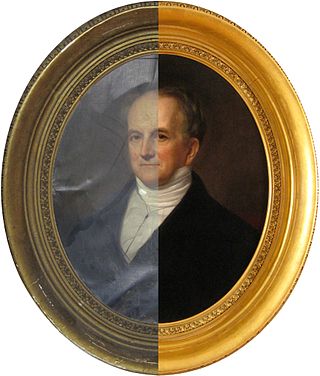
The conservation and restoration of painting frames is the process through which picture frames are preserved. Frame conservation and restoration includes general cleaning of the frame, as well as in depth processes such as replacing damaged ornamentation, gilding, and toning.

Kashmiri papier-mâché is a handicraft of Kashmir that was brought by Muslim saint Mir Sayyid Ali Hamadani from Persia in the 14th century to medieval India. It is based primarily on paper pulp, and is a richly decorated, colourful artifact; generally in the form of vases, bowls, or cups, boxes, trays, bases of lamps, and many other small objects. These are made in homes, and workshops, in Srinagar, and other parts of the Kashmir Valley, and are marketed primarily within India, although there is a significant international market. The product is protected under the Geographic Indication Act 1999 of Government of India, and was registered by the Controller General of Patents Designs and Trademarks during the period from April 2011 to March 2012 under the title "Kashmir Paper Machie".

The conservation and restoration of paintings is carried out by professional painting conservators. Paintings cover a wide range of various mediums, materials, and their supports. Painting types include fine art to decorative and functional objects spanning from acrylics, frescoes, and oil paint on various surfaces, egg tempera on panels and canvas, lacquer painting, water color and more. Knowing the materials of any given painting and its support allows for the proper restoration and conservation practices. All components of a painting will react to its environment differently, and impact the artwork as a whole. These material components along with collections care will determine the longevity of a painting. The first steps to conservation and restoration is preventive conservation followed by active restoration with the artist's intent in mind.
The conservation-restoration of panel paintings involves preventive and treatment measures taken by paintings conservators to slow deterioration, preserve, and repair damage. Panel paintings consist of a wood support, a ground, and an image layer. They are typically constructed of two or more panels joined together by crossbeam braces which can separate due to age and material instability caused by fluctuations in relative humidity and temperature. These factors compromise structural integrity and can lead to warping and paint flaking. Because wood is particularly susceptible to pest damage, an IPM plan and regulation of the conditions in storage and display are essential. Past treatments that have fallen out of favor because they can cause permanent damage include transfer of the painting onto a new support, planing, and heavy cradling. Today's conservators often have to remediate damage from previous restoration efforts. Modern conservation-restoration techniques favor minimal intervention that accommodates wood's natural tendency to react to environmental changes. Treatments may include applying flexible battens to minimize deformation or simply leaving distortions alone, instead focusing on preventive care to preserve the artwork in its original state.
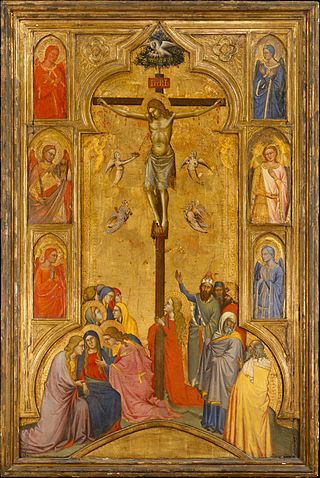
Gold ground or gold-ground (adjective) is a term in art history for a style of images with all or most of the background in a solid gold colour. Historically, real gold leaf has normally been used, giving a luxurious appearance. The style has been used in several periods and places, but is especially associated with Byzantine and medieval art in mosaic, illuminated manuscripts and panel paintings, where it was for many centuries the dominant style for some types of images, such as icons. For three-dimensional objects, the term is gilded or gold-plated.
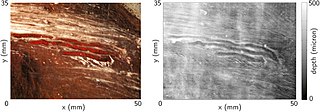
In visual arts, the ground is a prepared surface that covers the support of the picture and underlies the actual painting. Occasionally the term is also used in a broad sense to designate any surface used for painting, for example, paper for watercolor or plaster for fresco.
In visual arts, the support is a solid surface onto which the painting is placed, typically a canvas or a panel. Support is technically distinct from the overlaying ground, but sometimes the latter term is used in a broad sense of "support" to designate any surface used for painting, for example, paper for watercolor or plaster for fresco.
















